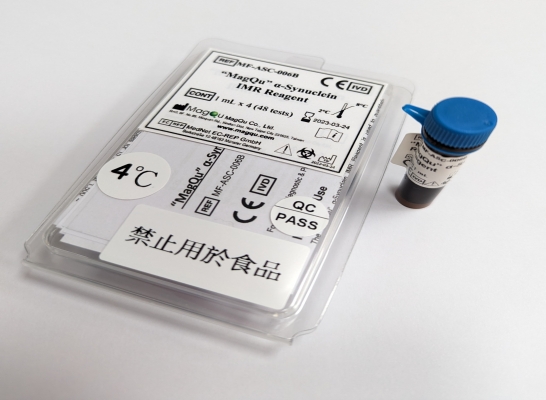Product

“MagQu” α-Synuclein IMR Reagent
- Catalog No. MF-ASC-006B
- CE-IVD Certification
- For rapid quantifying α-Synuclein by Immuno Magnetic Reduction (IMR).
- Quantify α-Synuclein in the sample easily, rapidly, and accurately
- Magnetic Nanoparticle
- Dextran layer
- For Parkinson's disease research and for in-vitro diagnosis use
Intended Use
“MagQu” α-Synuclein IMR Reagent is used to quantitatively measure α-Synuclein in human fluid specimen, such as plasma, serum or CSF.
Use “MagQu” α-Synuclein IMR Reagent only with the XacPro-S System (MagQu Co., Ltd.).
Introduction
α-Synuclein (SNCA) is a presynaptic neuronal protein and is abundant in the human brain. α-Synuclein aggregates to form insoluble fibrils in pathological conditions characterized by Lewy bodies, such as Parkinson's disease (PD), dementia with Lewy bodies (DLB) and multiple system atrophy (MSA). These disorders are known as synucleinopathies. α-Synuclein is the primary structural component of Lewy body fibrils. Occasionally, Lewy bodies contain tau protein; however, α-Synuclein and tau constitute two distinctive subsets of filaments in the same inclusion bodies. α-Synuclein pathology is also found in both sporadic and familial cases with Alzheimer's disease.1, 2, 3
Principles of Test
“MagQu” α-Synuclein IMR reagent is designed for quantifying α-Synuclein protein by Immuno Magnetic Reduction (IMR). We conjugate antibody on the surface of around 50 nm-in-diameter Fe3O4 magnetic particles. When the antibodies on the surface bind with α-Synuclein protein, the magnetic particles form clusters. Therefore, the ac susceptibility (Xac) of magnetic particles would be reduced in the applied ac magnetic field. By measuring the reduction of Xac, we can quantify α-Synuclein protein in the sample easily and accurately.4, 5
References
- Anzari Atik, Tessandra Stewart, Jing Zhang, “Alpha-synuclein as a biomarker for Parkinson's disease”, Brain Pathology, Volume 26, Issue 3, pages 410–418, May 2016
- Oskar Hansson, Sara Hall, Annika Öhrfelt, Henrik Zetterberg, Kaj Blennow, Lennart Minthon, Katarina Nägga, Elisabet Londos, Shiji Varghese, Nour K Majbour, Abdulmonem Al-Hayani, Omar MA El-Agna, “Levels of cerebrospinal fluid α-Synuclein oligomers are increased in Parkinson's disease with dementia and dementia with Lewy bodies compared to Alzheimer's disease”, Hansson et al. Alzheimer's Research & Therapy, 2014, 6:25.
- D.J. Irwin, V.M.Y. Lee, and J.Q. Trojanowski, “Parkinson's disease dementia convergence of α-Synuclein, tau and amyloid-β pathologies”, Nat Rev Neurosci., 14, 626–636, 2013.
- C.Y. Hong, C.C. Wu, Y.C. Chiu, S.Y. Yang, H.E. Horng, H.C. Yang, “Magnetic susceptibility reduction method for magnetically labeled immunoassay”, Appl. Phys. Lett. , 88, 212512-1–212512- 3, 2006.
- C.C. Yang, S.Y. Yang, C. S. Ho, et al, ”Development of antibody functionalized magnetic nanoparticles for the immunoassay of carcinoembryonic antigen: a feasibility study for clinical use.”, Journal of Nanobiotechnology, 2014, 12:44.
| Catalog Number | Description | Package Size |
|---|---|---|
| MF-ASC-006B | CE-IVD | 1 mL x 4 (48 tests) |
| MF-ASC-006B | For Research Use Only | 1 mL x 4 (48 tests) |
- Applications Content:Quantitative detection for ultra-low-concentration bio-molecules, e.g. α-Synuclein-disease bio-markers in blood.






